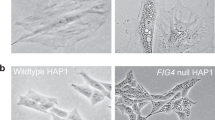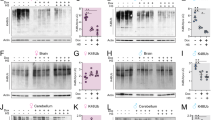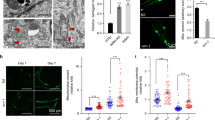Abstract
Neuronal ceroid-lipofuscinoses (NCL) are autosomal recessive disorders that form the most common group of progressive neurodegenerative diseases in children, with an incidence as high as 1 in 12,500 live births, and with approximately 440,000 carriers in the United States1,2. Disease progression is characterized by a decline in mental abilities, increased severity of untreatable seizures, blindness, loss of motor skills and premature death. The CLN3 gene, which is responsible for Batten disease, has been positionally cloned3. The yeast gene, denoted BTN1, encodes a non-essential protein that is 39% identical and 59% similar to human CLN3 ( ref. 4). Strains lacking Btn1p, btn1-Δ, are resistant to D-(-)-threo-2-amino-1-[p-nitrophenyl]-1,3-propanediol (ANP) in a pH-dependent manner5. This phenotype was complemented by expression of human CLN3, demonstrating that yeast Btn1p and human CLN3 share the same function5. Here, we report that btn1-Δ yeast strains have an abnormally acidic vacuolar pH in the early phases of growth. Furthermore, DNA microarray analysis of BTN1 and btn1-Δ strains revealed differential expression of two genes, with at least one, HSP30, involved in pH control. Because Btn1p is located in the vacuole, we suggest that Batten disease is caused by a defect in vacuolar (lysosomal) pH control. Our findings draw parallels between fundamental biological processes in yeast and previously observed characteristics of neurodegeneration in humans.
This is a preview of subscription content, access via your institution
Access options
Subscribe to this journal
Receive 12 print issues and online access
$209.00 per year
only $17.42 per issue
Buy this article
- Purchase on Springer Link
- Instant access to full article PDF
Prices may be subject to local taxes which are calculated during checkout




Similar content being viewed by others
References
Goebel, H.H. The neuronal ceroid lipofuscinoses. J. Child. Neurol. 10, 424–437 (1995).
Banerjee, P., Dasgupta, A. Siakotas, A. & Dawson, G. Evidence for lipase abnormality: high levels of free and triacylglycerol forms of unsaturated fatty acids in neuronal ceroid-lipofuscinoses. Am. J. Med. Genet. 42, 549–554 (1992).
International Batten Disease Consortium. Isolation of a novel gene underlying Batten disease. Cell 82, 949–957 (1995).
Pearce, D.A. & Sherman, F. BTN1, a yeast gene corresponding to the human gene responsible for Batten's disease, is not essential for viability, mitochondrial function, or degradation of mitochondrial ATP synthase. Yeast 13, 691–697 ( 1997).
Pearce, D.A. & Sherman, F. A yeast model for the study of Batten disease. Proc. Natl Acad. Sci. USA 95, 6915 –6918 (1998).
Pearce, D.A., Nosel, S.A. & Sherman, F. Studies of pH regulation by Btn1p, the yeast homolog of human Cln3p. Mol. Genet. Metab. 66, 320 –323 (1999).
Pearce, D.A. & Sherman, F. Investigation of Batten disease with the yeast Saccharomyces cerevisiae. Mol. Genet. Metab. 66, 314–319 (1999).
Manolson. M.F. et al. The VPH1 gene encodes a 95-kDa integral membrane polypeptide required for in vivo assembly and activity of yeast vacuolar H+-ATPase. J. Biol. Chem. 267, 14294 –14299 (1992).
Piper, P.W., Ortiz-Calderon, C., Holyoak, C., Coote, P. & Cole, M. Hsp30, the integral plasma membrane heat shock protein of Saccharomyces cerevisiae, is a stress-inducible regulator of plasma membrane H+-ATPase. Cell Stress Chaperones 2, 12–24 ( 1997).
Kramer, H. & Phistry, M. Mutations in the Drosophila hook gene inhibit endocytosis of the boss transmembrane ligand into multivesicular bodies. J. Cell Biol. 133, 1205 (1996).
Niedenthal, R.K., Riles, L., Johnston, M. & Hegemann, J.H. Green fluorescent protein as a marker for gene expression and subcellular localization in budding yeast. Yeast 12, 773–786 (1996).
Croopnick, J.B., Choi, H.C. & Mueller, D.M. The subcellular location of the yeast Saccharomyces cerevisiae homologue of the protein defective in juvenile form of Batten disease. Biochem. Biophys. Res. Comm. 250, 335–341 (1998).
Paulsen, I.T., Sliwinski, M.K., Nelissen, B., Goffeau, A. & Saier, M.H. Jr Unified inventory of established and putative transporters encoded within the complete genome of Saccharomyces cerevisiae. FEBS Lett. 430, 116–125 (1998).
Jarvela, I. et al. Biosynthesis and intracellular targeting of the CLN3 protein defective in Batten disease. Hum. Mol. Genet. 7, 85–90 (1998).
Haltia, M., Rapola, L., Santavuori, P. & Keranen, A. Infantile type of so-called neuronal ceroid lipofuscinosis. 2. Morphological and biochemical studies. J. Neurol. Sci. 18, 269–285 (1973).
Koenig, H., McDonald, T. & Nellhaus, G. Morphological and histochemical studies of neurolipidosis by light and electron microscopy. J. Neuropathol. Exp. Neurol. 23, 191–193 ( 1964).
Hall, N.A., Lake, B.D., Dewji, N.N. & Patrick, N.D. Lysosomal storage of subunit c of mitochondrial ATP synthase in Batten's disease. Biochem. J. 275, 269–272 (1991).
Palmer, D.N. et al. Mitochondrial ATP synthase subunit c storage in the ceroid-lipofuscinoses (Batten disease). Am. J. Med. Genet. 42, 561–567 (1992).
Cox, G.A. et al. Sodium/hydrogen exchanger gene defect in slow-wave epilepsy mutant mice. Cell 91, 139–148 (1997).
Hemenway, C.S. et al. vph6 mutants of Saccharomyces cerevisiae require calcineurin for growth and are defective in vacuolar H+-ATPase assembly. Genetics 141, 833– 844 (1995).
Zinser, E. & Daum, G. Isolation and biochemical characterization of organelles from the yeast, Saccharomyces cerevisiae. Yeast 11, 493–536 ( 1995).
Serrano, R. Characterization of the plasma membrane ATPase of Saccharomyces cerevisiae . Mol. Cell. Biochem. 22, 51 (1978).
Morano, K.A. & Klionsky, J. Differential effects of compartment deacidification on the targeting of membrane and soluble proteins to the vacuole in yeast. J. Cell Sci. 107, 2813– 2824 (1994).
Preston, R.A., Murphy, R.F. & Jones, E.W. Assay of vacuolar pH in yeast and identification of acidification-defective mutants. Proc. Natl Acad. Sci. USA 86, 7027–7031 (1989).
DeRisi, J.L., Iyer, V.R. & Brown, P.O. Exploring the metabolic and genetic control of gene expression on a genomic scale. Science 278, 680– 686 (1997).
Sambrook, J., Fritsch, E.F. & Maniatis, T. in Molecular Cloning: A Laboratory Manual (Cold Spring Harbor Laboratory Press, Cold Spring Harbor, 1989).
Acknowledgements
We thank D.M. Mueller for sharing results before publication; T. Langer for providing unpublished results with Btn1p-GFP; E.W. Jones for the VPH1+ and vph1-Δ strains; S. Gibson for technical assistance in measuring vacuolar pH; and D. Goldfarb for the use of a fluorescent microscope. Supported by NIH grant R01 NS36610 and NCI grant CA 36856.
Author information
Authors and Affiliations
Corresponding author
Rights and permissions
About this article
Cite this article
Pearce, D., Ferea, T., Nosel, S. et al. Action of BTN1, the yeast orthologue of the gene mutated in Batten disease. Nat Genet 22, 55–58 (1999). https://doi.org/10.1038/8861
Received:
Accepted:
Issue Date:
DOI: https://doi.org/10.1038/8861
This article is cited by
-
Exploring the power of yeast to model aging and age-related neurodegenerative disorders
Biogerontology (2017)
-
Neuronal ceroid lipofuscinosis protein CLN3 interacts with motor proteins and modifies location of late endosomal compartments
Cellular and Molecular Life Sciences (2012)
-
Regulation of Saccharomyces cerevisiae Plasma membrane H+-ATPase (Pma1) by Dextrose and Hsp30 during Exposure to Thermal Stress
Indian Journal of Microbiology (2011)
-
A metabolomic comparison of mouse models of the Neuronal Ceroid Lipofuscinoses
Journal of Biomolecular NMR (2011)
-
Modelling neurodegeneration in Saccharomyces cerevisiae: why cook with baker's yeast?
Nature Reviews Neuroscience (2010)



